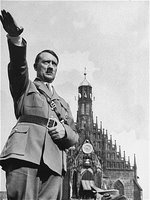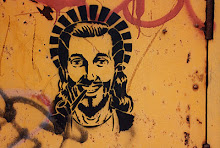 In 1932 Nazis began joining local parishes in a clandestine effort to undermine the Church's power to resist Hitler's rise to power. By 1935, two-thirds of the membership of the Martin Luther Memorial Church were members of the Nazi party.
In 1932 Nazis began joining local parishes in a clandestine effort to undermine the Church's power to resist Hitler's rise to power. By 1935, two-thirds of the membership of the Martin Luther Memorial Church were members of the Nazi party.The church building was built in 1929, designed in the Bauhaus style. The inside was modifed by the Nazi members in the 1930s.
“There was a bust of Adolf Hitler in the nave,” Isolde Boehm, dean of the church, said, the Times of London reports. “A carved face of Hitler has been replaced by one of Martin Luther. There is even a rumour that the church was supposed to be called the Adolf Hitler Church.”
The image of a Nazi storm trooper side by side with Jesus Christ has been carved into the pulpit. An Iron Cross-shaped chandelier illuminates the entrance
Bare patches in the walls marks where swastikas have been ripped out.
Two Protestant priests — Frau Boehm and the Reverend Malte Jungnickel — want to have the church declared a listed building. They are asking the German government to fund restoration of the church, expected to cost €3 million (£2 million or $3.6 million US).
"Look at the face of Christ on the cross," Herr Jungnickel said. "It is the face of a victorious Aryan, with a bodybuilder’s frame, not the suffering Jesus."
"So far, thank God, the neo-Nazis have not discovered the church as a place of pilgrimage," Frau Boehm said. [Neo-Nazis apparently don't have the Internet, and will never read this. — Ed.]
German art critics find themselves in an ethical dilemma: How much Nazi iconography should be saved?
The Nazi church is something of an embarassment; it reminds people of how clearly the Protestant Church aligned itself to Hitler.
Bells embosssed with the swastika rang at the church until 1942, when they were melted down for use in war munitions.
Not all the church members during the Second World War were Nazis or Nazi sympathizers, however. Max Kurzreiter, the local priest in the 1930s, gave shelter to members of the dissident anti-Nazi Confessional Church.
And prominent anti-Nazi and writer Jochen Klepper married a Jewish convert at the church in 1938. "That required a great deal of courage from the priest," Herr Jungnickel said.
Klepper, his wife and one of his daughters killed themselves in December 1942. "The problem we will always have with this unique church is that whenever we stand in the pulpit and say something, we have to preach against our surroundings; that’s incredibly hard," Frau Boehm said.
"Somehow we have to find a way of preserving the building, keeping its interior as a warning, but also supplement it with a documentation centre explaining the complicated history of the church in the Third Reich."
Nazi | Hitler | Third Reich
Christianity | Protestant | Martin Luther Memorial Church

No comments:
Post a Comment